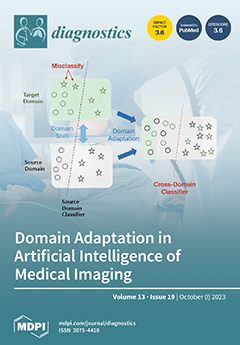Background and Objectives: Peripheral artery disease (PAD) affects both genders, but the knowledge of clinical and therapeutic aspects particular to each gender has a prognostic value, modulating the risk of amputation and helping to reduce the risk of death or the occurrence of an acute vascular event secondary to optimal management.
Materials and Methods: We conducted a retrospective, descriptive study that included 652 patients with PAD who were evaluated at “St. Spiridon” Hospital’s Cardiology Department and divided into two groups according to gender: women (100 cases) and men (552 cases). We evaluated demographics, anthropometric data, as well as clinical and paraclinical parameters in the two groups.
Results: Men had a lower mean age (
p < 0.001), higher mean BMI (
p = 0.049) and were more frequent smokers. (
p = 0.008). Hypercholesterolemia (
p = 0.026), obesity (
p = 0.009), concomitant cerebrovascular (
p = 0.005) and chronic kidney disease (
p = 0.046) were more common in women, while coronary artery disease (
p = 0.033) was more common in men. The number of angiographic stenotic lesions (
p = 0.037) is a statistically significant parameter in our study, with both genders predominantly associated with stenotic lesions. In addition, directly proportional relationships were found between smoking, uric acid, inflammatory markers, and the number of stenotic lesions and thromboses or the ankle–brachial index (ABI). In the subgroup of men, the number of stenotic and thrombosed lesions positively correlated with the ABI value (
p < 0.001). The presence of more than three cardiovascular risk factors (
p = 0.001) and serum triglyceride levels (
p = 0.019) significantly correlated with the number of angiographically detected lesions. We applied several risk scores (PREVENT III, Finnvasc Score, or GermanVasc risk score) in our study group for prognostic purposes, without showing statistically significant differences between genders. Men, rest pain, gangrene, smoking status, the presence of more than three cardiovascular risk factors, or a serum HDL-cholesterol level below 40 mg/dL (
p < 0.001 for all parameters) are independent predictors associated with amputation in our study group.
Conclusions: In our study, we demonstrated that several clinical–paraclinical particularities guide the diagnosis, providing the clinician with prognostic and therapeutic tools to choose the optimal management with maximum benefits.
Full article






